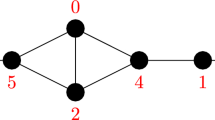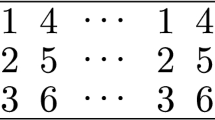Abstract
An equitable graph coloring is a proper vertex coloring of a graph G where the sizes of the color classes differ by at most one. The equitable chromatic number, denoted by \(\chi _{eq}(G),\) is the smallest number k such that G admits such equitable k-coloring. We focus on enumerative algorithms for the computation of \(\chi _{eq}(G)\) and propose a general scheme to derive pruning rules for them: We show how the extendability of a partial coloring into an equitable coloring can be modeled via network flows. Thus, we obtain pruning rules which can be checked via flow algorithms. Computational experiments show that the search tree of enumerative algorithms can be significantly reduced in size by these rules and, in most instances, such naive approach even yields a faster algorithm. Moreover, the stability, i.e., the number of solved instances within a given time limit, is greatly improved. Since the execution of flow algorithms at each node of a search tree is time consuming, we derive arithmetic pruning rules (generalized Hall-conditions) from the network model. Adding these rules to an enumerative algorithm yields an even larger runtime improvement.






Similar content being viewed by others
References
Ahuja, R. K., Magnati, T. L., & Orlin, J. B. (1993). Network flows: Theory, algorithms, and applications. Upper Saddle River, NJ: Prentice-Hall, Inc.
Brélaz, D. (1979). New methods to color the vertices of a graph. Communications of the ACM, 22, 251–256.
de Werra, D. (1997). Restricted coloring models for timetabling. Discrete Mathematics, 165, 161–170.
de Werra, D. (1999). On a multiconstrained model for chromatic scheduling. Discrete Applied Mathematics, 94(1), 171–180.
Goldberg, A. V. (1985). A new max-flow algorithm, Technical Report MIT/LCS/TM-291. Laboratory for Computer Science, Massachusetts Institute of Technology.
Hajnal, A., & Szemerédi, E. (1970). Proof of a conjecture. In P. Erdös, A. Rényi & V. T. Sós (Eds.), Combinatorial theory and its application (pp. 601–623). London: North-Holland.
Hoffman, A. J. (1960). Some recent applications of the theory of linear inequalities to extremal combinatorial analysis. Proceedings of Symposia in Applied Mathematics, 10, 113–127.
Kierstead, H. A., Kostochka, A. V., Mydlarz, M., & Szemerédi, E. (2010). A fast algorithm for equitable coloring. Combinatorica, 30(2), 217–224.
Lih, K.-W. (2013). Equitable coloring of graphs. In P. M. Pardalos, D.-Z. Du & R. L. Graham (Eds.), Handbook of combinatorial optimization (pp. 1199–1248). New York: Springer.
Méndez-Díaz, I., Nasini, G., & Severín, D. (2013). An exact DSATUR-based algorithm for the equitable coloring problem. Electronic Notes in Discrete Mathematics, 44, 281–286.
Méndez-Díaz, I., Nasini, G., & Severín, D. (2014a). A polyhedral approach for the equitable coloring problem. Discrete Applied Mathematics, 164(II), 413–426.
Méndez-Díaz, I., Nasini, G., & Severín, D. (2014b). A tabu search heuristic for the equitable coloring problem. LNCS, 8596, 347–358.
Méndez-Díaz, I., Nasini, G., & Severín, D. (2015). A DSATUR-based algorithm for the equitable coloring problem. Computers & Operations Research, 57, 41–50.
Meyer, W. (1973). Equitable coloring. American Mathematical Monthly, 80, 920–922.
Siek, J., Lee, L., & Lumsdaine, A. (2015). Boost Graph Library. http://www.boost.org/libs/graph.
Tucker, A. (1973). Perfect graphs and an application to optimizing municipal services. SIAM Review, 15(3), 585–590.
Acknowledgements
This work is partially supported by the German Federal Ministry of Education and Research (BMBF Grant No. 05M13PAA, joint project 05M2013-VINO: Virtual Network Optimization). Moreover, it was supported by an RWTH Aachen Seed Fund project and the RWTH Aachen Undergraduate Funds, both funded by the Excellence Initiative of the German Federal and State Governments.
We thank our student assistants Sven Förster and Duc Thanh Tran for their work, especially regarding implementations and testing.
Author information
Authors and Affiliations
Corresponding author
Rights and permissions
About this article
Cite this article
Koster, A.M.C.A., Scheidweiler, R. & Tieves, M. A flow based pruning scheme for enumerative equitable coloring algorithms. Ann Oper Res 272, 3–28 (2019). https://doi.org/10.1007/s10479-017-2451-1
Published:
Issue Date:
DOI: https://doi.org/10.1007/s10479-017-2451-1




